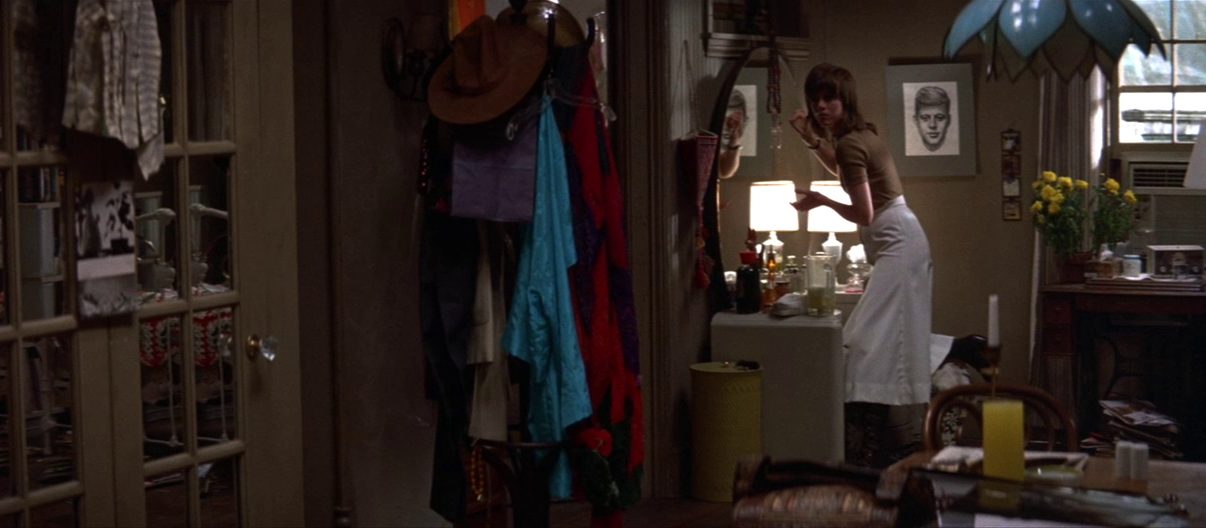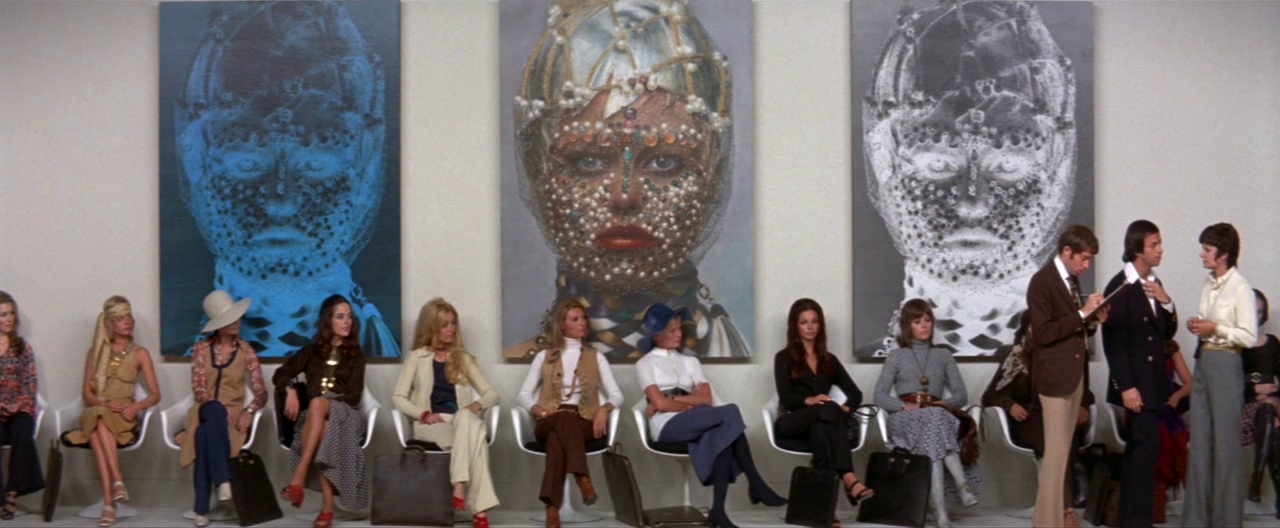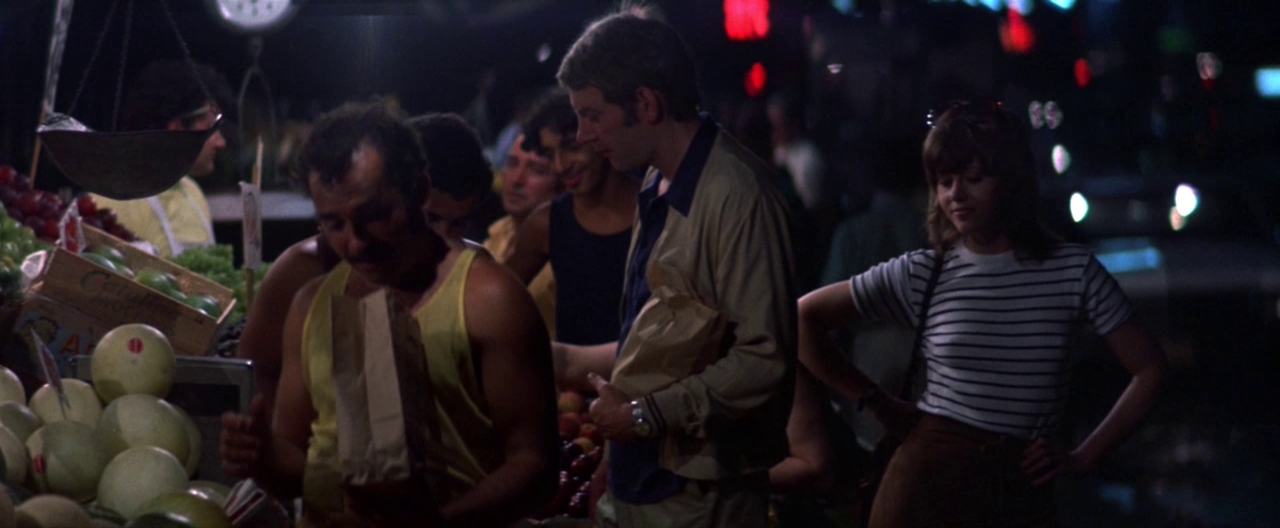

“Don’t feel bad about losing your virtue. I sort of knew you would. Everybody always does.”
Early on in Alan J. Pakula’s Klute, call girl Bree Daniels (Jane Fonda) trades her body for money, then comes home to her studio apartment, takes a bath, lights some candles and flicks off the overhead bulbs, settles into a chair at her kitchen table, pours herself a glass of wine, and smokes from a spliff. Into quiet stillness she begins timidly singing a centuries-old hymn called ‘We Gather Together’ which asks for the Lord’s blessing and praises His divine wisdom. It’s a brilliant (apparently improvised) moment that shows a character twisted into knots of contradiction.
As many others have pointed out over the years, Klute arguably bears the wrong name (not that a film called Bree would hold the same mystique as Klute). To be sure, Donald Sutherland’s John Klute and his investigation into the disappearance of Tom Gruneman (Robert Milli) only gives the film an identifiable frame (like Lea Massari’s disappearance in L’Avventura), while its narrative attention and thematic concerns almost entirely revolve around Bree’s struggle to reform her ways and leave her sordid past behind her. In a film full of closeups, the most affecting are uncut shots of Fonda unloading her introspections to a clinical psychologist (Vivian Nathan).
We do start with Mr. Gruneman’s disappearance though. An abrupt cut rips us from a lively dinner party with the man in attendance to the same location some time later, where police suggest the only clue that might help them solve his disappearance is a collection of obscene letters that he’d written but never sent to one Bree Daniels. They were found in his desk at the chemical company where he worked as an executive. She’s contacted and shown photographs, but she’s turned so many tricks that she admits she often doesn’t remember faces for very long. After several months of fruitless searching, Gruneman’s boss Peter Cable (Charles Cioffi) agrees to hire Klute, family friend and journeyman gumshoe, to take a look into the case.

It’s only then that we are introduced to Bree at a casting call, unremarkably situated in the middle of a lineup so inconspicuously that if you didn’t know who Jane Fonda was your eyes might alight upon any of the dozen or so other prospective models. This lack of attention is clearly intentional, underscoring Bree’s quest to blend in, to be nothing more than another pretty girl trying to break into a cutthroat industry in New York City. It makes sense then, that when Klute comes knocking at her door asking about details of a past client, she shuts the door in his face. She doesn’t want the attention. But he’s resolute—aided by his prudish tact, which sees him treating her strictly as an interview subject instead of like a prostitute, or even an attractive woman—and eventually he manages to enlist her help in tracking down the barely-remembered man who, we’ll learn pretty quickly, is definitely not Gruneman. And so this odd couple find themselves bouncing between strung out prostitutes (Dorothy Tristan), sympathetic madams (Rita Gam, Shirley Stoler), and oily pimps (Roy Scheider), looking for any scrap of a clue that might clarify the fate of the missing man.
As they spend more time together—an arrangement forced upon them by Bree’s growing paranoia and Klute’s mounting intuition that she might be next on the mystery man’s killing spree (her fears underscored by a giallo-tinged score from Michael Small)—Bree’s inner turmoil is explored further, with Klute’s boy scout presence providing further impetus for self-loathing and the emergence of a moral conscience. As she tells her shrink, this unplanned, organic falling in love business is baffling and bewildering to her. She’s never felt it before and she finds herself resisting it, trying to destroy it out of habit, subconsciously wishing for the “comfort of being numb again.” (Andy and Dave Lewis were nominated for an Oscar for their screenplay, but their subsequent careers seem to have proven that it was Pakula and his actors who elevated the material.)

While the argument can be made that Klute’s catalytic presence might justify his titular status, few would argue that Fonda isn’t the hands-down star of the show (though I’d be happy to entertain arguments for the exquisite work of cinematographer Gordon Willis which visually matches Alan J. Pakula’s storytelling sense beat for beat). In her first of two Oscar winning performances, Fonda excels on every level, even as her character reveals the full gamut of her conflicted accretion of wants and needs. She’s emotionally vulnerable, but bold and quick-witted; paranoid, but brave; willfully independent, but hopelessly dependent; selfish, but sensitive; ugly, but beautiful. Willis’ camera often lingers on her for more than a minute without cutting and she remains firmly in-character, fleshing out her persona and seamlessly embodying thematic concerns as diverse as the sexual revolution and the intrusion of mass surveillance. It’s a standout among a stacked list of superbly directed performances by Pakula.
Pakula’s second feature and the first of his so-called “Paranoia Trilogy” (The Parallax View, All the President’s Men), Klute often gets overlooked in favor of the other two films in that unofficial collection. And though it may indeed have been surpassed by Pakula’s own films and thematically similar works from Coppola (The Conversation), De Palma (Blow Out), and others, it was one of the first languid anti-mystery type films that de-emphasized conventional thrills in favor of less obvious aims, like Altman’s The Long Goodbye and Penn’s Night Moves.